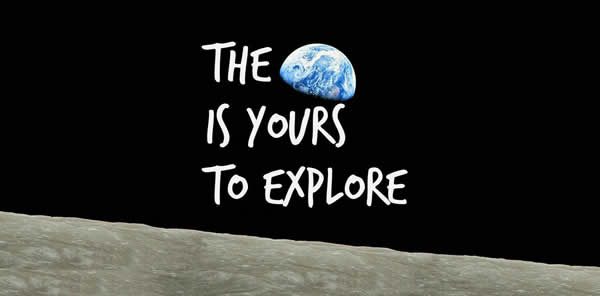HiRISE images
Bedforms on crater rims

A Piece of Mars: Dunes and ripples most commonly form in topographic lows. But not in this 0.96x0.54 km (0.6x0.34 mi) scene. Here, and in other places on Mars, these bedforms (called TARs) form on plains, and sometimes appear to cling to the rims of craters - which are topographic highs, not lows. It's not clear how this happens: Does the topography of the crater rim provide a wind shadow that allows windblown sediment to accumulate there? Or was there simply more loose material on the crater rims to begin with, allowing these things to form in place? I'm open... read more ❯
Shadows behind boulders

A Piece of Mars: Bright material (either dust or sand) has accumulated in the lee of wagon- to car-sized boulders in this 0.96x0.54 km (0.6x0.34 mi) scene. It's perhaps something like the Rocknest sand shadow that Curiosity visited a few years back. The wind blows from lower right to upper left, carrying along sediment that occasionally gets trapped in the protected areas behind the boulders. These sand shadows aren't very thick, as the underlying texture (polygonal terrain!) is visible through them. (HiRISE ESP_047798_1150, NASA/JPL/Univ. of Arizona) read more ❯
Dunes and rock hurdles in Gale crater (3D)

A Piece of Mars: Wind from the upper left is blowing dark dunes toward the lower right in this 1.92x1.08 km (1.19x0.67 mi) anaglyph (if you don't have your red/blue 3D glasses handy, you can also check out the black and white 2D version). The dunes are crossing through hurdles aligned to make their progress as difficult as possible, but the dunes nevertheless are slowly making their way through. Ironically, the bright "hurdles" are themselves lithified dunes that are perhaps billions of years old. (HiRISE ESP_020555_1755/ESP_047139_1755 NASA/JPL/Univ. of Arizona) read more ❯
On Mars the wind carves stream channels

A Piece of Mars: This 1.6x2 km (1x1.24 mi) scene mostly shows what wind will do to fine-grained, weakly-consolidated surfaces. It has created topography that further strengthens wind scour in the hollows, which even leave kilometers-long grooves reminiscent of water-carved streams. If this were Earth I'd guess they had been carved by water first. But this is Mars, where the wind is in charge. (HiRISE ESP_046504_1785, NASA/JPL/Univ. of Arizona) read more ❯
Windblown: ancient and recent

A Piece of Mars: HiRISE is celebrating 10 years of success by showcasing its first high resolution image, taken back in 2006. Here is a portion of it, shown at 1/4 the full resolution (the scene is 2.5x2.5 km across). I highly recommend downloading the HiRISE image viewer and looking at the whole thing, it's an amazing landscape. The portion shown here has many different ripple-like features, formed by a wind blowing from left to right. Notice that those in the middle and middle-left are a bit fainter: these are ripple-like features that were carved into the bedrock by the... read more ❯
Is it windblown or not?

A Piece of Mars: This 480x270 m (0.30x0.17 mi) scene shows what are being called "ridges". Were these ridges once dunes that have now been stabilized and eroded? They have some dune-like characteristics: nearly parallel crests, one slope is steeper than the other, that steep slope seems to have exposed layers, and sometimes the crests meet in what is called a "Y-junction" (based on the letter's shape). But although they're common in some areas on Mars, they're not like any dunes or ripples I'm familiar with. I'm inclined to think they're not ancient dunes, but it's likely that the wind... read more ❯
Light and dark

A Piece of Mars: This 0.96x0.54 km (0.6x0.34 mi) late winter scene is a study in contrast. The dark top half is uniformly rippled. This is the shady surface of the main windward side of one of Mars' biggest dunes, in Kaiser crater. On the bottom is the sunlit side of the dune, strewn with gullies colored by CO2 frost (white), dark basaltic sand (black), and what may be oxidized fines (orange). (HiRISE ESP_045614_1330, NASA/JPL/Univ. of Arizona) read more ❯
Shades and textures

A Piece of Mars: This 480x270 m (0.3x0.17 mi) scene shows the contact between two very different terrains. On the left is a bright surface with polygonal cracks (characteristic of periglacial terrain - this is at a high latitude). On the right is a dark rippled sand sheet that superposes the polygonally-cracked surface. The long meandering furrows might be the beginnings of polygonal cracking in the sand, which might expand if wind doesn't erase them. (HiRISE PSP_006473_1125, NASA/JPL/Univ. of Arizona) read more ❯
Eroded dune

A Piece of Mars: Barchan dunes on Mars have a characteristic crescent shape, with a steep slope ("slip face") on the inside of the sharpest curve (see examples like this, this, these, or this). This image (873x491 m, or 0.54x0.31 mi) shows an example of a dune that probably looked a bit like those other dunes did once, but it's been highly eroded so that the characteristic curved slip face is no longer the steepest slope. This dune is located pretty far north, so I'm betting it's been stabilized by ice, so that the wind can no longer easily reshape... read more ❯
Where does the windblown stuff come from?

A Piece of Mars: How far do windblown materials move on Mars? This scene (0.9x1.2 km, 0.56x0.75 mi) shows a bright layer of bedrock (top right) that is eroding, exposing a darker, bluish rock (bottom left). Ripples 5-20 m wide have slowly moved towards the lower right, with some migrating into the darker terrain. Those near the interface show that they're made of stuff from the brighter terrain, as they are still brighter than the dark, bluish bedrock. But those at the bottom are much more blue. This means that this type of ripple incorporates material from nearby rocks: unlike... read more ❯